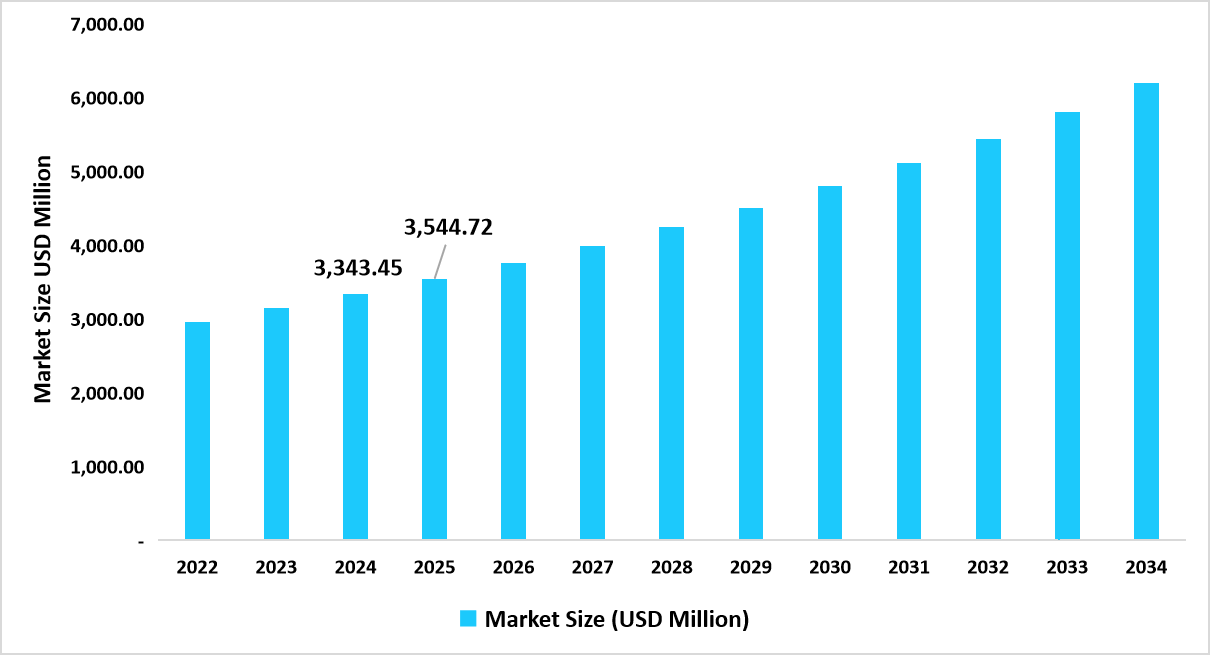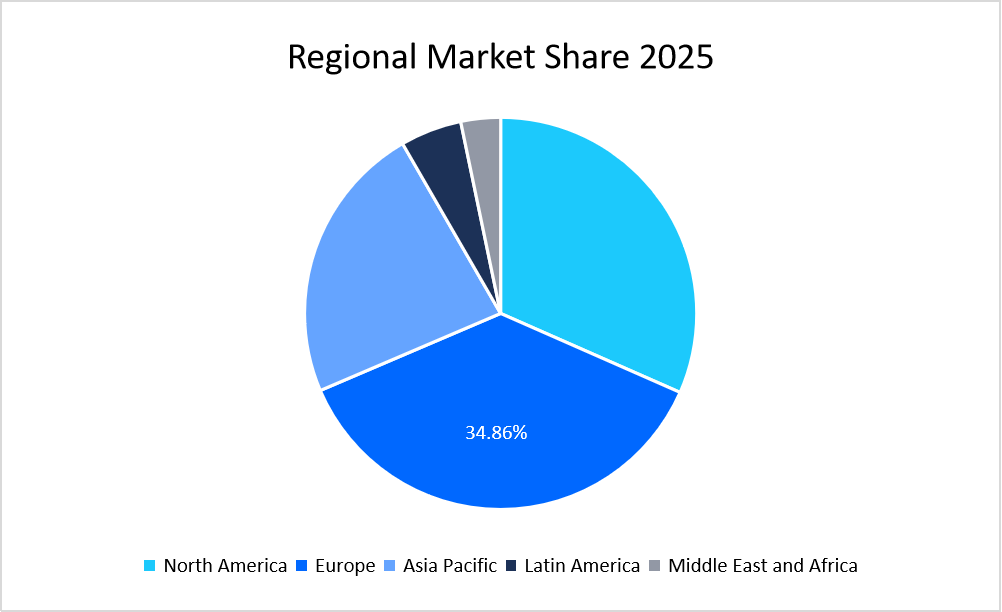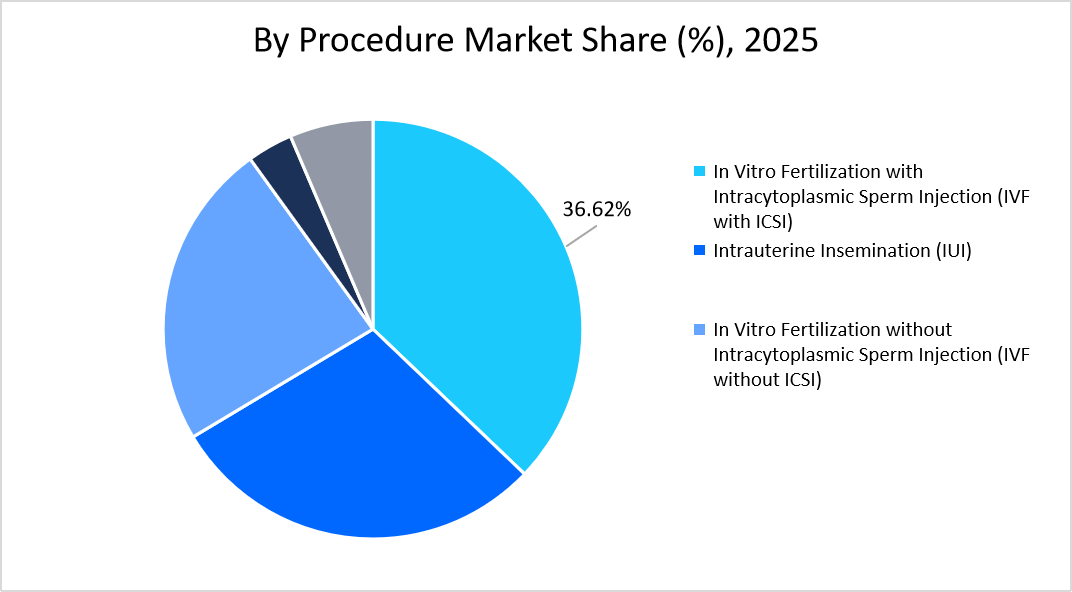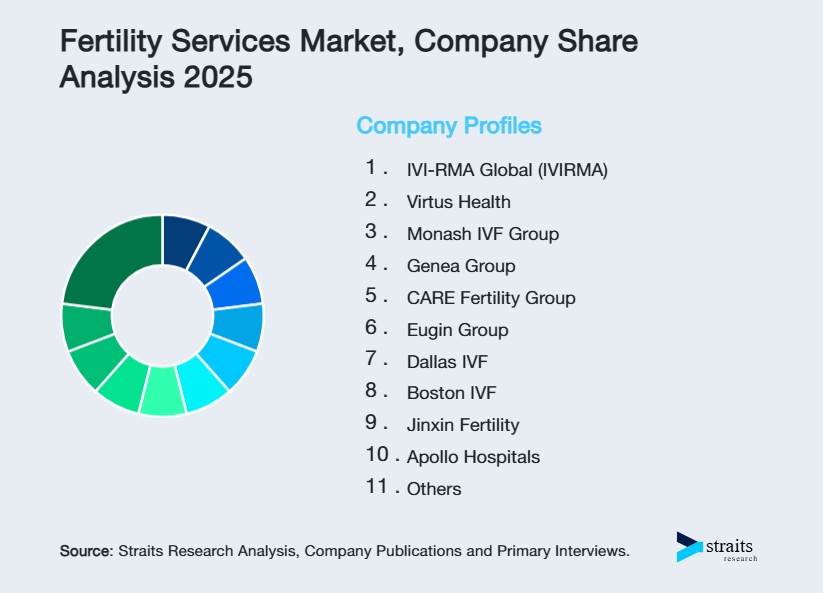Fertility Services Market Overview
The global fertility services market size is valued at USD 45.33 billion in 2025 and is estimated to reach USD 79.28 billion by 2034, growing at a CAGR of 6.45% during the forecast period. Consistent growth of the market is supported by the increasing integration of genetic screening and preimplantation testing, which allows early detection of hereditary disorders, improves implantation success, and encourages couples to seek advanced reproductive solutions proactively.
Key Market Trends & Insights
- Europe dominated the market with a revenue share of 34.86% in 2025.
- Asia Pacific is anticipated to grow at the fastest CAGR of 7.25% during the forecast period.
- Based on procedure, the in vitro fertilization with intracytoplasmic sperm injection (IVF with ICSI) segment held the highest market share of 36.62% in 2025.
- By service, the egg & embryo banking segment is estimated to register the fastest CAGR growth of 6.71%.
- Based on provider, the fertility clinics segment dominated the market in 2025.
- Based on type, the female fertility services segment is projected to register the fastest CAGR during the forecast period.
- Germany dominates the fertility services market, valued at USD 3.34 billion in 2024 and reaching USD 3.54 billion in 2025.
Table: Germany Fertility Services Market Size (USD Million)

Source: Straits Research
Market Size & Forecast
- 2025 Market Size: USD 45.33 billion
- 2034 Projected Market Size: USD 79.28billion
- CAGR (2026-2034): 6.45%
- Dominating Region: Europe
- Fastest-Growing Region: Asia-Pacific
The global fertility services market includes various procedures such as in vitro fertilization with intracytoplasmic sperm injection (IVF with ICSI), intrauterine insemination (IUI), in vitro fertilization without intracytoplasmic sperm injection (IVF without ICSI), surrogacy, and others. These procedures are provided through the following services, such as fresh non-donor, frozen non-donor, egg & embryo banking, fresh donor, and frozen donor. Moreover, these services are provided through fertility clinics, hospitals, surgical centers, and clinical research institutes.
Rising demand for fertility preservation among cancer patients undergoing chemotherapy, integration of mental health support within fertility programs, and the use of wearable devices for real time hormone and ovulation tracking are the key factors driving market growth.
Latest Market Trends
Shift from fragmented clinic visits to connected care through telemedicine
Fertility treatment delivery is moving from fragmented, clinic dependent interactions to digital ecosystems that integrate teleconsultations, mobile health apps, and remote monitoring. In the past, patients faced challenges of repeated in person visits, high travel costs, and time intensive procedures, which limited adherence. Now, digital fertility platforms offer virtual consultations, real time cycle tracking, and remote diagnostics, enabling continuity of care from home. For example, in 2024, Progyny partnered with Maven Clinic to expand virtual fertility support through telehealth consultations and digital coaching, notably improving patient engagement and retention. Thus, clinical studies show that these digital engagement tools improve treatment compliance and lower dropout rates, reflecting a major shift in fertility care standards.
Exponential rise in IVF born children
According to Straits Research, an exponential rise in IVF born children is a key trend in fertility services market. In the early years of the late 1970s, IVF was considered highly experimental and accounted for only a handful of births globally. However, there is a sharp increase in IVF births from 1980 to 2025. The International Committee for Monitoring Assisted Reproductive Technology (ICMART) 2025, reported that more than 13 million babies had been born through IVF until 2024, highlighting a massive leap in adoption and acceptance of fertility services.
This growth reflects how IVF has transformed from a limited option to a mainstream reproductive solution accepted by millions worldwide, which is driving demand for fertility services as an essential part of modern healthcare.

To get more insights about this report Download Free Sample Report
Market Driver
Rising popularity of fertility tourism
Fertility care is increasingly moving towards cross border reproductive services, emerging as a major growth driver for the fertility services market. Countries such as Turkey, Spain, India, Czech Republic, Greece, and Thailand are becoming the leading hubs due to their liberal legal frameworks, specialized expertise, and cost advantages. For example, according to the European Society of Human Reproduction and Embryology (ESHRE) 2024, Spain performed more than 165,000 ART cycles annually, with nearly 40% of patients traveling from abroad, largely attracted by favorable egg donation laws.
This strong inflow of international patients is fueling IVF tourism and boosting the global fertility services market size.
Market Restraint
High cost of fertility treatments is limiting accessibility
A major restraint in the fertility services market is the high cost of advanced procedures, which prevents patients from accessing treatment. As per the American Society for Reproductive Medicine (ASRM, 2024), the average cost of one IVF cycle in the U.S. ranges between USD 15,000 and 25,000.
Therefore, in countries with low insurance coverage, this expense becomes unaffordable for a large segment of patients. As a result, the high price of IVF continues to restrict widespread adoption of fertility services globally.
Market Opportunity
Adoption of new digital strategies
The adoption of advanced digital health strategies to improve treatment success rates is creating new scope for market growth. In March 2024, Australia’s Virtus Health successfully implemented an AI-powered embryo selection system, and the leading fertility expert Prof. Peter Illingworth highlighted that AI will soon become the dominant approach in IVF embryo selection.
Such innovations not only improve clinical outcomes but also support remote patient engagement. Thus, AI integration is creating opportunities for providers to deliver more effective, accessible, and patient centric fertility services.
Regional Analysis
Europe dominated the market in 2025, accounting for 34.86% market share. This dominance is attributed to transparent ART registries and detailed outcome reporting that helped patients compare results and choose clinics confidently. Further, the growing investments from venture capital and private equity firms in areas such as femtech, cryopreservation, and IVF technologies have fueled clinic expansion and modernization. In addition, Europe benefits from collaborative research projects and large registries managed by professional societies, which speed up the adoption of new fertility techniques such as advanced embryo diagnostics and culture systems. These factors are collectively driving the adoption of fertility services in European countries.

Source: Straits Research
The UK market growth is driven by its focus on providing highly safe fertility services. According to HFEA data, single embryo transfer rates increased to around 88% of IVF cycles by 2024, while multiple birth rates dropped to about 3–4%, improving maternal and child health outcomes. Thus, strong regulation and publicly available data continue to build trust, boosting the country’s market growth.
Asia Pacific Market Trends
Asis Pacific is emerging as the fastest-growing region with a CAGR of 7.25% from 2026-2034, owing to countries such as India, Thailand, and Malaysia, which are attracting international patients with competitive pricing and bundled IVF packages, while Japan and South Korea are advancing fertility technologies through strong government support and R&D initiatives. These regional policies promoting reproductive health awareness and private sector expansion in fertility chains are further accelerating the adoption of fertility services in the Asia Pacific.
India’s fertility services market is expanding rapidly through domestic accessibility programs and large-scale private clinic networks. For example, India Fertility and IVF Centre offered zero-interest EMI plans along with free expert consultations, making advanced IVF treatments affordable for middle-class couples. In addition, Indira IVF, one of the largest fertility chains in the country, was awarded the Best IVF/Fertility Chain of the Year in 2024, reflecting both service quality and scale. These financing models and expansive private networks positioned India as a growing hub in the global fertility services industry.
North American Market Trends
North America is witnessing steady expansion in fertility services, driven by growing employer sponsored fertility benefits and wider insurance coverage across the U.S. and Canada, encouraging more couples to pursue assisted reproduction. Moreover, Canadian public health initiatives are improving accessibility to IVF in select provinces also supports the market growth.
The U.S. fertility services market growth is propelled by the integration of fertility preservation into oncology care. Partnerships between fertility centers and cancer institutes, such as MD Anderson Cancer Center and Shady Grove Fertility, are enabling rapid referral systems for gamete cryopreservation prior to chemotherapy. Supported by NIH backed oncofertility initiatives and specialized biobanking infrastructure, these collaborations ensure timely fertility preservation for cancer patients, expanding the clinical scope of U.S. fertility services.
Latin America Fertility Services Market Insights
Latin America fertility services market is driven by countries such as Mexico, Brazil, and Argentina, which are developing ethical gamete donation frameworks ensuring transparent donor matching. Additionally, tele-fertility platforms in this region are bridging geographic gaps, which supports international patients to access consultations and treatment planning.
Brazil’s fertility services market is expanding as more women choose to preserve their fertility for future family planning. Leading clinics such as Rede D’Or São Luiz and Fertivitro now offer advanced egg freezing services, supported by employer health programs and corporate wellness initiatives, improving accessibility and promoting reproductive autonomy nationwide.
Middle East and Africa Fertility Services Market Insights
The Middle East and Africa fertility services market is expanding as countries introduce fertility treatments that align with cultural and religious values. Leading centers such as Dubai Fertility Centre and Saudi German Hospital follow government approved Sharia compliant IVF protocols, increasing patient confidence and acceptance.
Egypt fertility services market is growing as the government promotes assisted reproduction research and expands affordable IVF programs in public hospitals. These initiatives make advanced fertility treatments accessible to middle income families, reducing cost barriers and encouraging more couples to seek medical support for infertility across the country.
Procedure Insights
The in vitro fertilization with intracytoplasmic sperm injection (IVF with ICSI) segment dominated the market with a revenue share of 36.62% in 2025. This growth was driven by the increasing number of women delaying parenthood. As more women opt for egg freezing to delay parenthood, IVF with ICSI was preferred because it maximizes fertilization success with thawed eggs, ensuring higher reliability in planned fertility treatments.

Source: Straits Research
Service Insights
The egg & embryo banking segment was expected to register the fastest CAGR growth of 6.71% during the forecast period. This growth was attributed to oncofertility programs strongly recommending embryo banking before chemotherapy and radiation therapy. As these treatments damage fertility, patients preserve gametes in advance to overcome future challenges. This medical necessity expanded the banking segment rapidly, thereby supporting the segment's growth.
Service Providers Insights
Fertility clinics dominated the market in 2025, as many fertility clinics now provide bundled end-to-end service, including diagnostics, counseling, genetic testing, and advanced lab services. This integrated model reduced patient dropouts and built trust by minimizing referrals to external providers.
Type Insights
Female fertility services were expected to grow at the fastest rate, driven by the growing awareness around conditions such as endometriosis and polycystic ovary syndrome. As more women are being diagnosed earlier, they are actively seeking specialized treatments to preserve fertility, increasing demand for targeted services to address these health challenges.
Competitive Landscape
The global fertility services market was moderately fragmented, with the availability of established fertility clinics and specialized service providers. Very few players account for the major market share through their extensive service portfolio and integrated benefit platforms. On the other hand, various regional providers cater to local markets.
The major players in the market include Virtus Health, Monash IVF Group, CARE Fertility, INVO Fertility, and others. These industry players competed with each other to gain a strong market foothold through the launch of new services, mergers, and acquisitions strategies.
Kindbody: An emerging market player
Kindbody was an emerging U.S.-based fertility service provider that combined a national network of clinics. The company differentiated itself by offering integrated care from fertility testing to IVF treatments.
- In February 2024, Kindbody announced that it had become the fertility benefits provider for more than 130 U.S. employers, highlighting its rapid expansion in employer-driven fertility coverage.
Thus, Kindbody emerged as a significant player in the global market, leveraging employer coverage and innovative clinic models.
List of key players in Fertility Services Market
- IVI-RMA Global (IVIRMA)
- Virtus Health
- Monash IVF Group
- Genea Group
- CARE Fertility Group
- Eugin Group
- Dallas IVF
- Boston IVF
- Jinxin Fertility
- Apollo Hospitals
- Medicover Group
- Apricity Fertility UK Limited
- King’s Fertility Limited
- Mayo Foundation for Medical Education and Research
- Shady Grove Fertility
- Indira IVF
- Cloudnine Fertility
- Global Fertility Solutions Pvt Ltd.
- Bourn Hall Fertility Clinic
- Instituto Bernabeu
- Others

To get more findings about this report Download Market Share
Strategic Initiatives
- 4thJune 2025: Samartha Fertility and IVF, India’s leading fertility service provider, announced the start of a mass IVF program. Under this program, Samartha offered high quality IVF cycles at just USD 965 per cycle.
- 2ndJune 2025: FIGO launched oncofertility best practices for preserving fertility for cancer patients.
- 3rdFebruary 2025: Esco Medical partnered with MIM Fertility, a Poland based deeptech for IVF clinics and laboratories. This partnership aimed at integrating products with advanced technologies such as artificial intelligence.
- 13thJanuary 2025: NewGenIvf Group Limited launched its innovative lifetime egg freezing service in Asia.
Report Scope
| Report Metric | Details |
|---|---|
| Market Size in 2025 | USD 45.33 Billion |
| Market Size in 2026 | USD 48.09 Billion |
| Market Size in 2034 | USD 79.28 Billion |
| CAGR | 6.45% (2026-2034) |
| Base Year for Estimation | 2025 |
| Historical Data | 2022-2024 |
| Forecast Period | 2026-2034 |
| Report Coverage | Revenue Forecast, Competitive Landscape, Growth Factors, Environment & Regulatory Landscape and Trends |
| Segments Covered | By Procedure, By Service, By Service Provider, By Type, By Region. |
| Geographies Covered | North America, Europe, APAC, Middle East and Africa, LATAM, |
| Countries Covered | U.S., Canada, U.K., Germany, France, Spain, Italy, Russia, Nordic, Benelux, China, Korea, Japan, India, Australia, Taiwan, South East Asia, UAE, Turkey, Saudi Arabia, South Africa, Egypt, Nigeria, Brazil, Mexico, Argentina, Chile, Colombia, |
Explore more data points, trends and opportunities Download Free Sample Report
Fertility Services Market Segmentations
By Procedure (2022-2034)
- In Vitro Fertilization with Intracytoplasmic Sperm Injection (IVF with ICSI)
- Intrauterine Insemination (IUI)
- In Vitro Fertilization without Intracytoplasmic Sperm Injection (IVF without ICSI)
- Surrogacy
- Others
By Service (2022-2034)
- Fresh Non-donor
- Frozen Non-donor
- Egg & Embryo Banking
- Fresh Donor
- Frozen Donor
By Service Provider (2022-2034)
- Fertility Clinics
- Hospitals
- Surgical Centers
- Clinical Research Institutes
By Type (2022-2034)
- Male Fertility Services
- Female Fertility Services
By Region (2022-2034)
- North America
- Europe
- APAC
- Middle East and Africa
- LATAM
Frequently Asked Questions (FAQs)
Debashree Bora
Healthcare Lead
Debashree Bora is a Healthcare Lead with over 7 years of industry experience, specializing in Healthcare IT. She provides comprehensive market insights on digital health, electronic medical records, telehealth, and healthcare analytics. Debashree’s research supports organizations in adopting technology-driven healthcare solutions, improving patient care, and achieving operational efficiency in a rapidly transforming healthcare ecosystem.
Speak To AnalystAvailable for purchase with detailed segment data, forecasts, and regional insights.
Get This ReportOur Clients:










































